#reptiles are cool
Explore tagged Tumblr posts
Text

Semi realistic Rathalos and Rathian.
21 notes
·
View notes
Text
i miss when my beardie was a baby, he was just so handsome

9 notes
·
View notes
Text

#photo of the day#photography#pond slider#turtle#i like turtles#reptile#reptiles are cool#nature photography#wildlife photography#wild nj#scenic#scenic photography#nikon photography#nikon coolpix p1000#Bayonne Park#nj isnt boring#fall 2024
7 notes
·
View notes
Text
Aquatic Reptile Character Poll
Alright so I apologize for not giving enough time on the last poll (I was tired and only gave you all one day as opposed to a week) so I may include another poll at the end. So what kind of aquatic reptile should I write?
@bloobluebloo @standingpillar @doveghost @asordidbarwere @stoneshrike
#poll#furry#furry anthro#scalie#scalie furry#writing#creative writing#writeblr#polls are fun#character poll#reptiles#aquatic reptiles#reptiles are cool#turtles#crocodillian#crocodiles#alligator#caiman#water snakes#basilisk#iguana#monitor
11 notes
·
View notes
Text
The list of reptiles of Lebanon
What if when we were born we were each assigned a Wikipedia page like a social security number would that be fucked up or what
126K notes
·
View notes
Text

Bruh,,,,
35K notes
·
View notes
Text
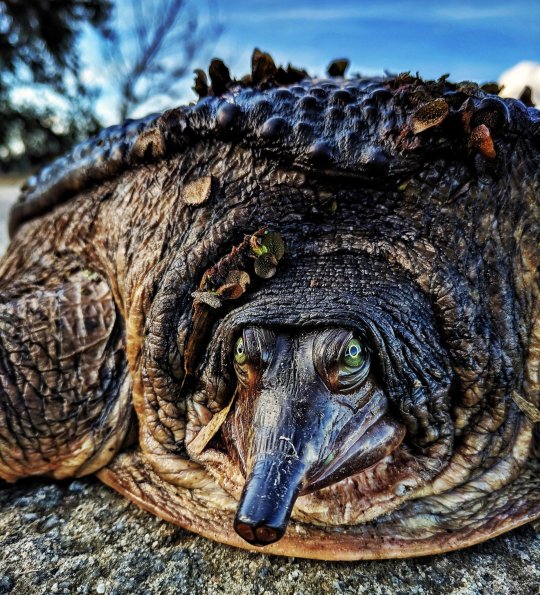
Sunshine State residents, do you recognize this little neighbor? It’s the Florida softshell turtle (Apalone ferox)! Unlike many turtles, you might find this critter darting about on land or swimming rapidly in water. Its hydrodynamic, flattened shell, and four strongly-webbed feet help it to move swiftly. Softshells stick mostly to water and have long necks and snouts that they poke above the surface, like a snorkel, to breathe. Juveniles have more contrasting color patterns than adults: their carapace, or shell, can be olive, tan, or light brown with spots and a yellow rim.
Photo: kimberry, CC BY-NC 4.0, iNaturalist
#science#nature#natural history#animals#did you know#fact of the day#turtles#herpetology#florida#cool animals#weird animals#reptile
3K notes
·
View notes
Note
could you draw Pomni with Gummigoo?
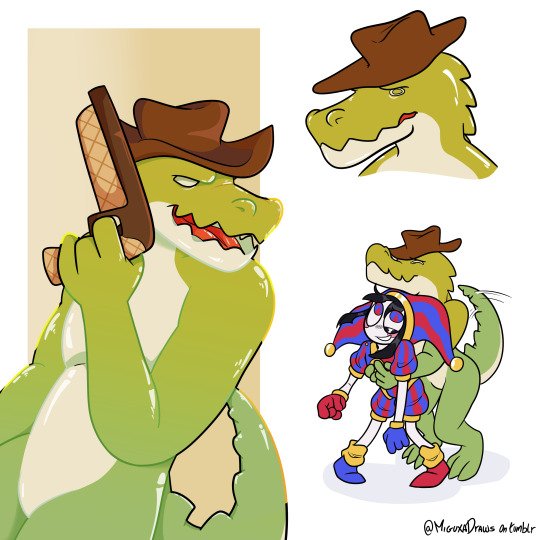
he looks very edible
#i'd take a bite out of him#NOT affectionately#i like gummies#but i like reptiles too#i love scalies tbh#a shame this one is edible#i'd actually eat him alive#my art#tadc#the amazing digital circus#tadc art#tadc fanart#digital circus#tadc pomni#pomni#pomni tadc#pomni fanart#tadc gummigoo#gummigoo#gummigoo tadc#gummigoo x pomni#pomni x gummigoo#funnygummy#gumni#jellyjester#cool shipnames lol
2K notes
·
View notes
Text

I joined a little art-community and this is the first task - to create a pattern. I managed to do seamless pattern! And these sneks are just lovely, aren't they? :)
#digital art#artist on tumblr#art#artists on tumblr#animal art#snake#snake art#nature art#ball python#python#snakes are cool#snek#reptile#serpent#danger noodle#illustration#digital illustration#pattern#digital artwork#no step on snek
723 notes
·
View notes
Text


Meet the wanibek
A small leviathan that the people of moga village have developed an unusual relationship with.
Used to assist in fishing, they are often equipped with a loose snare surrounding their jaws, allowing them to eat small fish,but makes them unable to consume the larger fish before the fishermen can get them.
The top one is a baby that makes chirping noises akin to real crocodilian babies, and can be carried around in their parent’s jaws.
They are small relatives of leviathans like Lagiacrus and Agnaktor, and like their pelagic cousin, they possess electroreception(although they cannot produce electricity). This is helpful for underwater hunts, as they can sense the presence of a large monster in murky water or if they’re hidden.
Engravings are often written into their horns, and these are the mounts an aspiring moga village hunter will use to traverse the many islands that make up this region of the world.
14 notes
·
View notes
Text
i have finally updated my list of animals to research that i wanna own and i am actually so hype :3 bf gave approval for anything smaller than he is tall, so i have up to 6’6” for snakes and stuff. which means im getting mostly males lol
#pets of tumblr#pets#exotic pets#my pets#pets and animals#reptiles are cool#reptiles#reptile#animal lover#animals
1 note
·
View note
Text
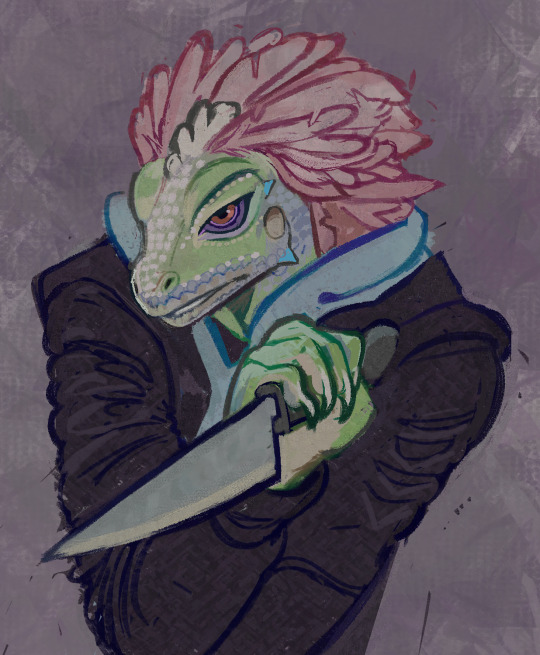
i know i made him look too cool let me have this 🦎
#spinner's hair always bothered me so much#like i love it-- it looks sick as hell on him but how tf does a reptile grow hair???????????#feathers. feathers is how#also i know his quirk is gecko but i was 30m into his chinese water dragon design before i remembered and now i think he looks too cool#may redesign again more gecko-ways#fanart#my art#bnha#bnha fanart#iguchi shuichi#spinner
504 notes
·
View notes
Text
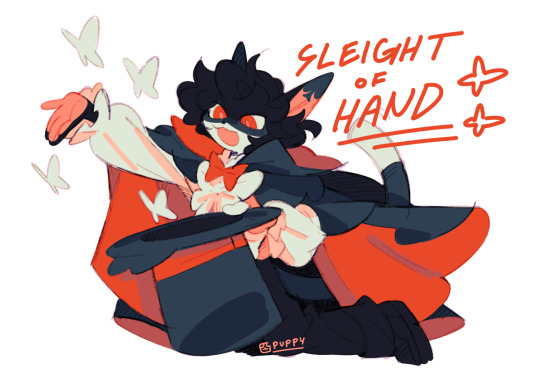

wanna see a magic trick? 🪄🎩
#YEAYYYY i like drawing this guy#now that i think abt it i cant remember the last time i saw a furry with tattoos.... ive decided not to think too hard about how it would#work but i think i like the idea of him getting playing card tats on his ears would be cool ^_^#apparently anthro species on furth include birds and mammals and i think fish amphibians and reptiles are non anthro#so instead of whipping out doves he would make white butterflies appear out of his hat :o)#its sort of meant to tie in with the ruffles on his shirt resembling a butterfly!!! i thought id make it close to a swallowtail so#that way its easy to see at a glance. i think that would look really cool irl#he looks a lot like joker p5 now that i look at it... it wasnt intentional but the red eyes and black messy hair is obvious huh#oh but the way his hair curls in the front isnt strictly in one direction just so that its easy to draw lol. its meant to curl around his#hat brim a little bc i thought it would look cool#my art#myart#my oc#oc#sleight#laika's comet#laika's comet oc#fan character#furry#furry art#fur
2K notes
·
View notes
Text
Namib Sand Geckos: these nocturnal geckos have biofluorescent markings that emit a bright, neon-green glow when exposed to the moonlight
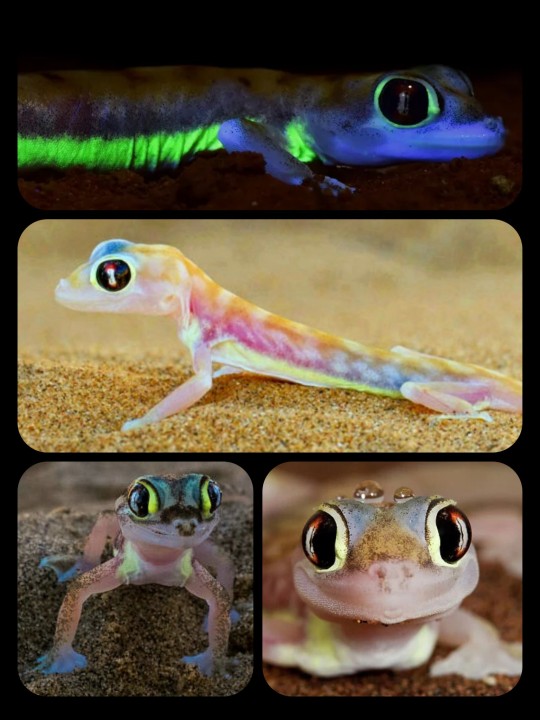
This species (Pachydactylus rangei) is found only in the Namib Desert, which stretches across Namibia, Angola, and South Africa; the geckos typically inhabit the arid, coastal region known as the Skeleton Coast.
In order to escape from the blistering heat of the desert, they use their webbed feet to burrow down into the sand during the day, and then emerge only at night, when the temperature has finally dropped. The webbing on their feet also enables them to run more easily across the dunes.

Namib sand geckos are covered in translucent scales, but they also have a strangely colorful appearance, as the colors/shades of their circulatory system, spinal column, internal organs, and optical membranes remain partially visible through the skin, producing various shades of pink, dark blue, purple, magenta, orange, and yellow.
They also have several distinctive markings running along their lower flank and encircling their eyes; these markings are known to fluoresce when exposed to UV light (including moonlight), emitting a bright, neon-green glow.

Some researchers have theorized that the biofluorescent markings may act as a signal to other geckos, allowing them to locate one another in the vast, desolate expanse of the desert, as this paper explains:
The fluorescent areas of P. rangei are concentrated around the eyes and along the lower flanks. This positioning is practically invisible to predators with a higher perspective (e.g. birds and jackals), but highly conspicuous from a gecko’s perspective. As P. rangei is sociable but generally solitary, and occurs at low population densities, such a signal might serve to locate conspecifics over greater distances ...
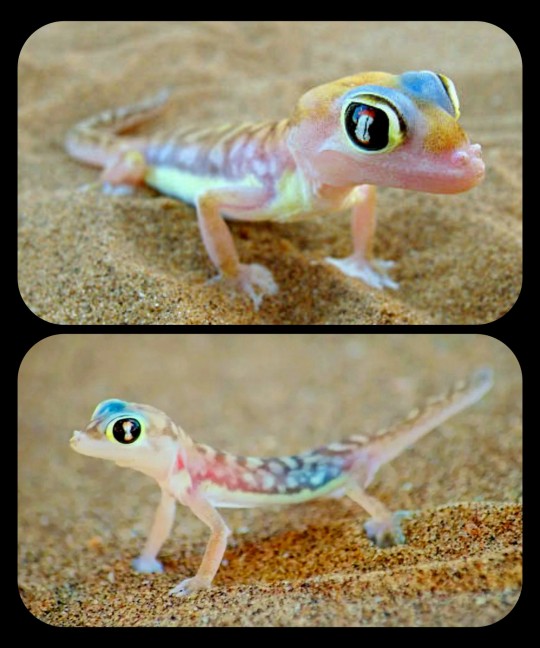
Encounters in P. rangei might serve purposes beyond mating opportunities: as the Namib desert has extremely low precipitation, fog is a key water source for its flora and fauna. Fog condenses on the bodies of the geckos, and they lick it from their faces. In husbandry, we have observed individuals licking water from conspecifics, taking advantage of a much greater available surface area.
Additionally, after short periods of isolation, the geckos run to meet each other. The combination of vital hydration with socialisation might reinforce signals that enable such meetings, and the cost of visibility to predators with higher vantage points, might constrain the signals to regions best visible from eye-level and below.
The Namib sand gecko is the only terrestrial vertebrate that is known to use an iridophore-based form of biofluorescence (you can find a more detailed explanation of that mechanism in the article mentioned above). The fluorescent dermal markings are also unique to this species.

Sources & More Info:
Scientific Reports: Neon-green fluorescence in the desert gecko Pachydactylus rangei caused by iridophores
Animal Diversity Web: Pachydactylus rangei
Dr. Mark D. Scherz's Blog: A Neon-Green Glowing Gecko!
Australian Geographic: Skeleton Coast - Namibia's strange desert dwellers
#herpetology#reptiles#gecko#Pachydactylus rangei#namib sand gecko#palmatogecko#namib desert#namibia#biofluorescence#animals that glow#lizards#cute animals#biology#nature#africa#squamata#web-footed gecko#cool animals#geckos#South Africa#Angola#Skeleton Coast#wildlife#not an arthropod#but still pretty cool
899 notes
·
View notes
Text
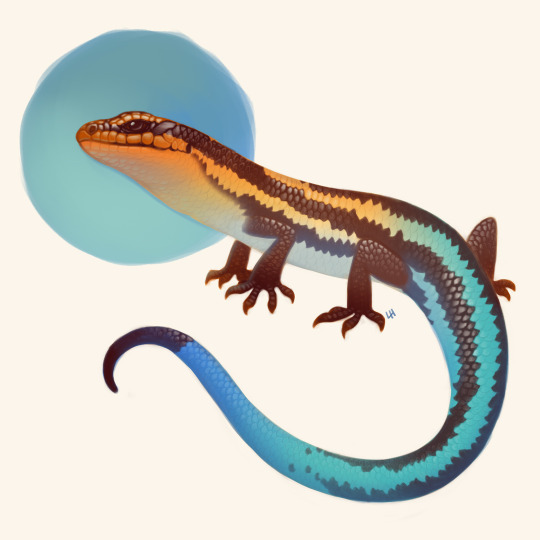
The 2D train continues! Featuring the Five lined skink 🦎
もっと2Dアートです! 今日のアートはオカダトカゲです 🦎
#art#アート#illustration#photoshop#reptilesofinstagram#reptile#reptileart#爬虫類#lizard#トカゲ#skink#herpetology#science#blue#青#red#赤い#cartoon#cool
547 notes
·
View notes
Text

Act like Megalochelys atlas and smile, because it’s Fossil Friday! One of the largest known land turtles, scientists think this massive reptile could reach heights of 5.9 ft (1.8 m)—tall enough to look a grown human in the eye. This specimen’s shell measures some 7.4 ft (2.3 m) long and in life, it may have weighed more than 2,000 lbs (907 kg). Megalochelys lived during the Late Pliocene about 2 million years ago. The fossil on display in the Museum’s Hall of Vertebrate Origins was found in 1922 in Chandigarh, India.
Photo: © AMNH
#science#amnh#museum#fossil#nature#natural history#animals#paleontology#turtle#herpetology#did you know#fact of the day#pliocene#fossil friday#cool animals#turtles#smile#ancient animals#reptiles
2K notes
·
View notes